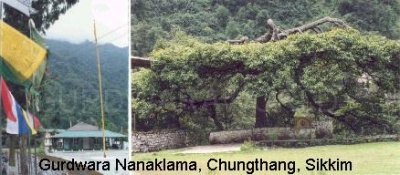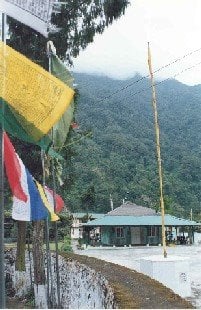Gurdwara Nanaklama Sahib
This wonderful historical Gurudwara is situated in Chungthang, which is a town in North Sikkim, an Indian state. Sikkim is a small but beautiful landlocked state nestled in the Himalayas in northern India. It is situated at the confluence of two rivers: River Lachen and Lachung Chu, both tributaries of the "most scenic" River Teesta. The thumb-shaped state borders Nepal in the west, the Chinese Tibet Autonomous Region to the north and east, Bhutan in the south-east and the Indian state of West Bengal to its south.
Chungthang is located in this state at a distance of 95 kilometres from the capital Gangtok, at an elevation of 1,700 metres (5,600 ft). Guru Dongmar is a lake at a height of 18,000 feet alongside a glacial peak known by the same name. The lake remains frozen most of the year due to heavy snowfall for almost six months each year.
History
It is believed Guru Nanak Dev ji visited this place during his trip (Udasi) to China and Tibet. Guru Nanak Dev ji dug his walking stick at a place where eventually the stick has grown into a tree which has trunk in stick shape and leaves are below the rounded trunk which looks like handle of stick. An amrit kund was also made to appear there by Guru ji. Guru Nanak visited the place during his third udasi in order to solace the Karma pa Nying ma pa sect then being hounded out from Tibet by the Ge lug pa sect. It is also said that Guru Nanak, on one of his journeys along with his disciples, had come across this place and vanquished two demons here before proceeding. The footprints of that battle were believed to be still left on that cordoned off rock. It is also said that Chungthang derived from the Punjabi, “Changa sthan” or good place, which Guru Nanak had bestowed on it. This however seems a little far-fetched
Guru Nanak reaching Guru Dongmar
Many from the Karma pa Nying ma pa sect were the followers of Guru Nanak, as their Head Lama became Guru Nanak's followers in Kailash Mansarovar area after being impressed by Guru Nanak's discussions with the famous Sidhas of the age. This sect had fled from Tibet to the Himalayan belt of Northern India, which included Ladakh, Himachal Pradesh, Uttra-Khand, Nepal, Sikkim, Bhutan, and Arunachal Pradesh. Records show that during his journeys to the Himalayas and the Far East, including China, Guru Nanak visited all these states around 1516 AD. After his visit to Kailash-Mansarovar, Guru Nanak returned along Kali River and went to Nepal, where an ancient Gurdwara at Kathmandu, on the bank of river Bishnumati commemorates his visit. Visiting various religious places in Nepal, he crossed over to Tibet through Nanak-la-pass and reached Sakya monastery. The earlier king of Tibet from Karma-pa sect was, by then, deposed by the Ge-lug-pa sect but was still holding on to this monastery. Guru Nanak helped Trasung Deochung reconstruct this monastery. Trasung Deochung honoured him with a robe that is preserved in Lachen Gompha.
From Tibet, Guru Nanak entered Sikkim through Chhorten Nyi ma la. Passing through Dolma Sampa and Tongpen, he entered Muguthang valley where he visited Kedang, Bendu, Sherang, Lyingka, and Muguthang. He went through Naku la and Lawu Gompha and reached plateau area around Guru Dongmar.
Problems Of Grazers
In this plateau the yak grazers approached Guru Nanak with a request, that: "they do not find water in winter as it gets frozen all over, temperature falling down to minus 35 degrees. "The Guru hit the perpetually snow-covered Guru Dongmar Lake with his stick to provide water to the grazers. The ice melted giving way to crystal clear water. Since then the water of the lake is stated to never freeze. The lake and the hill feature atop have come to be known as Gurudongmar Lake and hill respectively. The same names are found recorded in the ancient maps prepared by the British in nineteenth century. Some grazers projected another problem to Guru Nanak. Due to the effect of altitude, their virility was affected. They requested the Guru to do something about it. Guru Nanak blessed the lake, saying,"Whosoever takes the water of this lake will gain virility and strength and will be blessed with children." The people of the area have firm faith in Guru's words and consider the water of the lake as nectar. A Gurdwara was constructed in the eighties to commemorate Guru Nanak's visit to the place. We used to trek to Gurudongmar then, after travelling from Chungthang on foot, covering the distance in six days. The local people of the area and Lamas of Karma-pa Nying-ma-pa Sect confirm Guru Nanak's visit to these areas. The Lamas from these areas have been visiting Golden Temple, Amritsar, regularly to pay obeisance to their beloved Guru Rimpoche, Guru Nanak, also known as 'Nanak Lama in their areas.
Guru Ji headed towards Bhutan
Guru Nanak's footprints, a robe and a water-carrying utensil (kamandal) are preserved in Lachen Gompha, Sikkim, commemorating his visit to the place. From Gurudongmar, Guru Nanak went to Thangu, Lachen, Chungthang, Lachung, Yumthang and Pyakochin. At Chungthang a Gurdwara, a tree grown out of Guru's stick, footprints of the Guru, a spring, and the rice-fields blessed by Guru Nanak commemorate Guru Nanak's visit. At Pyakochin, an engraving on stone, in Gurmukhi script, was earlier preserved to commemorate the visit of Guru Nanak. From Pyakochin the Guru is stated to have crossed over to Chumbi Valley through Ghora-la, en-route to Bhutan.
Construction of Gurudwara
The present Gurdwara structure was built by officers of the Assam Rifles and Army personnel with the help of the local lepcha tribe in the early eighties. The area was restricted to service personnel and local people due to its strategic location near the border with China from the early eighties to 2005. The Assam rifles were transferred in September 2004 raising problems arose for the upkeep for the the Gurdwara. On 24th April 2005, "The Tribune" newspaper reported that the Gurdwara Nanklama at Chungthang Sikkim was opened to public and devotees for services. The Gurdwara was constructed after full inquiries from head lamas of Buddhist monestories (gomphas) at Fudong, Chungthang, Lachen, Lachung and Thangu and all the local people, and with their active help.
The author of this article crosschecked the above details given by various lamas from over fifty elderly people of the area. Lachen lama even promised to show the old records preserved with him that had an account of Guru Nanak's visit to the area. Staying as an "Observation Post Officer" at the height adjoining the lake, for over three months in 1987 and later in other areas adjoining, the author oversaw the development of the Gurdwara. People from all religions thronged the lake and the Buddhists had their regular fair on the lake.
They always paid obeisance at the Gurdwara with reverence. There was no question of any ill will. A Hindu temple was constructed in 1989 touching the Gurdwara, but was removed soon after mutual consultations. Thereafter everything remained cordial till 1994, as regularly watched by this author, who was operative in Sikkim and remained in touch with the Gurdwara till then. Later too, groups of Sikh pilgrims inspired by this author kept on visiting the gurdwara yearly without caring for the great hardships they had to face during the travel. They had all the goodwill of the local people and have sweet remembrance of their treatment.
References
- This itinerary is found recorded in Janam Sakhee Bhai Bala;
- Janam Sakhee Walait Wali;
- Janam Sakhee Meharban;
- Janam Sakhee B-40;
- Suchak Parsang by Bhai Behlo;
- Mahima Parkash by Baba Sarup Chand;
- Parchian Sewa Das;
- Nanak Prakash by Bhai Santokh Singh; Nanak Parkash,
- Twarikh Guru Khalsa and Gurdham Prakash by Gyani Gian Singh;
- Guru Khalsa Twareekh by Giani Lal Singh (Sangrur);
- Jeevan Charit Guru Nanak Dev ji by Dr. Trilochan Singh;
- Travels of Guru Nanak by Dr. Surinder Singh (Kohli);
- Atlas of Travels of Guru Nanak by Dr Fauja Singh and Kirpal Singh;
- Guru Nanak's Travels to Himalayan and East Asian Region by Dr. Dalvinder Singh (Grewal) (the author), and a host of other researchers.
- Though Janamsakhis and other contemporary material are vague about the names of the places, yet they are specific about Al-Lachen Bhutan Des which are specially mentioned in these Janamsakhis.


